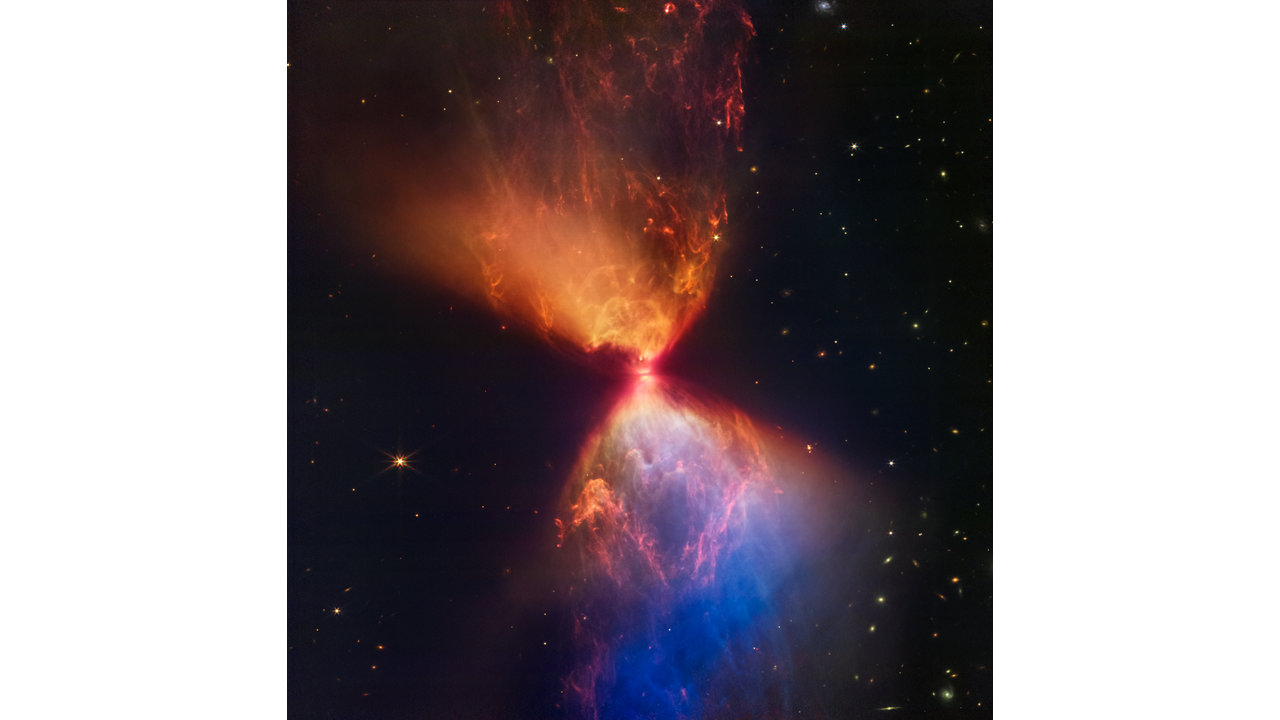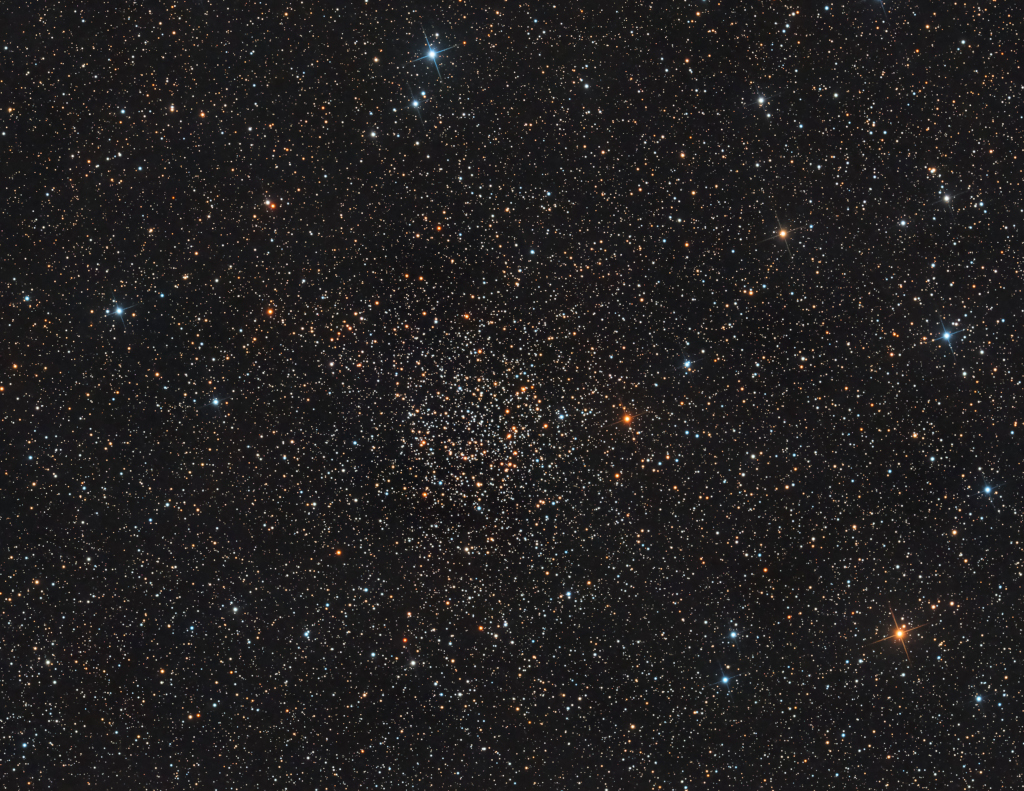Blog
L1527, shown in this image from NASA’s James Webb Space Telescope’s MIRI (Mid-Infrared Instrument), is a molecular cloud that harbors a protostar. It resides about 460 light-years from Earth in the constellation Taurus. The more diffuse blue light and the filamentary structures in the image come from organic compounds known as polycyclic aromatic hydrocarbons (PAHs), while the red at the center of this image is an energized, thick layer of gases and dust that surrounds the protostar. The region in between, which shows up in white, is a mixture of PAHs, ionized gas, and other molecules.

John Graham “Mitch” Mitchell (9 July 1946 – 12 November 2008) was an English drummer and child actor, best known for his work in the Jimi Hendrix Experience, for which he was inducted into the Rock and Roll Hall of Fame in 1992. He was inducted into the Modern Drummer Hall of Fame in 2009. In 2016, Mitchell was ranked number 8 in Rolling Stone magazine’s list of the “100 Greatest Drummers of All Time.
He spent his final days celebrating Hendrix’s music on the 2008 Experience Hendrix Tour. For nearly four weeks the tour travelled on an 18-city tour of the US, finishing in Portland, Oregon. The tour also featured Billy Cox, Buddy Guy, Jonny Lang, Robby Krieger, Kenny Wayne Shepherd, Eric Johnson, Cesar Rosas, David Hidalgo, Brad Whitford, Hubert Sumlin, Chris Layton, Eric Gales, and Mato Nanji.
Five days after the tour ended, Mitchell died in his sleep on 12 November, in his room at the Benson Hotel in Portland of natural causes.[24] Mitchell had been in ill health for many years due to an immune system disorder and cancer. Mitchell had earlier bouts with extreme fatigue but had recovered from them after a few days’ rest in 2007 and 2008.
more...Haydée Mercedes “La Negra” Sosa (Latin American Spanish: ; 9 July 1935 – 4 October 2009) was an Argentine singer who was popular throughout Latin America and many countries outside the region. With her roots in Argentine folk music, Sosa became one of the preeminent exponents of El nuevo cancionero. She gave voice to songs written by many Latin American songwriters. Her music made people hail her as the “voice of the voiceless ones”. She was often called “the conscience of Latin America.
Sosa performed in venues such as the Lincoln Center in New York City, the Théâtre Mogador in Paris, the Sistine Chapel in Vatican City, as well as sold-out shows in New York’s Carnegie Hall and the Roman Colosseum during her final decade of life. Her career spanned four decades and she was the recipient of six Latin Grammy awards (2000, 2003, 2004, 2006, 2009, 2011), including a Latin Grammy Lifetime Achievement Award in 2004 and two posthumous Latin Grammy Award for Best Folk Album in 2009 and 2011. She won the Premio Gardel in 2000, the main musical award in Argentina. She served as an ambassador for UNICEF.
more...Into the Woods tech week opening this Friday July 12th 2024 7pm thru July 21st 5pm @ Caponi Art Park in Eagan. Music by Raymond Berg, Lyra Olson, Paul Fonfara and mick laBriola.

Measuring the distance to truly remote objects like galaxies, quasars and galaxy clusters is a crucial task in astrophysics, particularly when it comes to studying the early Universe, but it’s a difficult one. Only in the case of a few nearby objects like the Sun, planets and some nearby stars can we measure their distances directly. Beyond that, various indirect methods need to be used; one of the most important is by examining Type Ia supernovae, and this is where the NASA/ESA Hubble Space Telescope comes in.
NGC 3810, the galaxy featured in this image, was the host of a Type Ia supernova in 2022. In early 2023 Hubble focused on this and a number of other galaxies to closely examine recent Type Ia supernovae. This kind of supernova results from a white dwarf exploding, and they all have a very consistent brightness. That allows them to be used to measure distances: we know how bright a Type Ia supernova should be, so we can tell how far away it must be from how dim it appears. One uncertainty in this method is that intergalactic dust in between Earth and a supernova blocks some of its light. How do you know how much of the reduction in light is caused by distance, and how much by dust? With the help of Hubble, there’s a clever workaround: take images of the same Type Ia supernovae in ultraviolet light, which is almost completely blocked by dust, and in infrared light, which passes through dust almost unaffected. By carefully noting how much light comes through at each wavelength, the relationship between supernova brightness and distance can be calibrated to account for dust. Hubble can observe both these wavelengths of light in great detail with the same instrument. That makes it the perfect tool for this experiment, and indeed, some of the data used to make this beautiful image of NGC 3810 were focused on its 2022 supernova. You can see it as a point of light just below the galactic nucleus, or in the annotated image here.
There are many ways to measure cosmic distances; because Type Ia supernovae are so bright, they are one of the most useful and accurate tools, when they’re spotted. Many other methods must be used as well, either as an independent check against other distance measurements or to measure at much closer or farther distances. One such method that also works for galaxies is comparing their rotation speed to their brightness; based on that method, NGC 3810 is found to be 50 million light-years from Earth.
[Image Description: A spiral galaxy seen almost face-on. Large spiral arms whirl out from its centre, filling the scene. They glow faintly blue from the stars within, with some small bright patches of blue and pink marking areas of star formation. They are overlaid with thin filaments of dark reddish dust that block light. The galaxy’s centre shines brightly white.]

John Lee Johnson (born July 8, 1944), frequently known by the stage names Jai Johanny Johanson and Jaimoe, is an American drummer and percussionist. He is best known as one of the founding members of the Allman Brothers Band and, with the death of Dickey Betts on April 18, 2024, he is the last surviving original member of the band.
Johanson played with a number of Muscle Shoals and Memphis soul acts in the early-to-mid 1960s, such as Otis Redding and Sam and Dave, as a session and touring drummer. While recording and touring he would meet the various members of what would become the Allman Brothers Band. One of the few bands at the time to employ two drummers, alongside Butch Trucks, they drew on R&B, blues, jazz, country, and rock to create a unique variety of southern rock. Upon the death of founding bassist Berry Oakley in 1972, Johanson brought in frequent collaborator Lamar Williams to replace him.
more...Johnnie Clyde Johnson (July 8, 1924 – April 13, 2005) was an American pianist who played jazz, blues, and rock and roll. His work with Chuck Berry led to his induction into the Rock and Roll Hall of Fame. He was posthumously awarded the Congressional Gold Medal for breaking racial barriers in the military as a Montford Point Marine, where he endured racism and inspired social change while integrating the previously all-white Marine Corps during World War II.
Johnson was born in Fairmont, West Virginia, United States. He began playing the piano in 1928. During World War II, he joined the United States Marine Corps and became a member of Bobby Troup‘s all-serviceman jazz orchestra: the Barracudas. After his service, Johnson moved to Detroit and then Chicago, where he sat in with many notable artists, including Muddy Waters and Little Walter.
more...Louis Thomas Jordan (July 8, 1908 – February 4, 1975) was an American saxophonist, multi-instrumentalist, songwriter and bandleader who was popular from the late 1930s to the early 1950s. Known as “the King of the Jukebox“, he earned his highest profile towards the end of the swing era. He was inducted into the Rock and Roll Hall of Fame as an “early influence” in 1987.
Specializing in the alto sax, Jordan played all forms of the saxophone, as well as piano and clarinet. He also was a talented singer with great comedic flair, and fronted his own band for more than twenty years. He duetted with some of the biggest solo singing stars of his time, including Bing Crosby, Ella Fitzgerald and Louis Armstrong.
more...Found among the rich starfields of the Milky Way, star cluster NGC 7789 lies about 8,000 light-years away toward the constellation Cassiopeia. A late 18th century deep sky discovery of astronomer Caroline Lucretia Herschel, the cluster is also known as Caroline’s Rose. Its visual appearance in small telescopes, created by the cluster’s complex of stars and voids, is suggestive of nested rose petals. Now estimated to be 1.6 billion years young, the galactic or open cluster of stars also shows its age. All the stars in the cluster were likely born at the same time, but the brighter and more massive ones have more rapidly exhausted the hydrogen fuel in their cores. These have evolved from main sequence stars like the Sun into the many red giant stars shown with a yellowish cast in this color composite. Using measured color and brightness, astronomers can model the mass and hence the age of the cluster stars just starting to “turn off” the main sequence and become red giants. Over 50 light-years across, Caroline’s Rose spans about half a degree (the angular size of the Moon) near the center of the sharp telescopic image.

Sir Richard Starkey MBE (born 7 July 1940), known professionally as Ringo Starr, is an English musician, songwriter and actor who achieved international fame as the drummer for the Beatles. Starr occasionally sang lead vocals with the group, usually for one song on each album, including “Yellow Submarine” and “With a Little Help from My Friends“. He also wrote and sang the Beatles songs “Don’t Pass Me By” and “Octopus’s Garden“, and is credited as a co-writer of four others.
Starr was afflicted by life-threatening illnesses during childhood, with periods of prolonged hospitalisation. As a teenager Starr became interested in the UK skiffle craze and developed a fervent admiration for the genre. In 1957, he co-founded his first band, the Eddie Clayton Skiffle Group, which earned several prestigious local bookings before the fad succumbed to American rock and roll around early 1958. When the Beatles formed in 1960, Starr was a member of another Liverpool group, Rory Storm and the Hurricanes. After achieving moderate success in the UK and Hamburg, he quit the Hurricanes when he was asked to join the Beatles in August 1962, replacing Pete Best.
In addition to the Beatles’ films, Starr has acted in numerous others. After the Beatles disbanded, he released several successful singles including the US top-ten hit “It Don’t Come Easy“, and number ones “Photograph” and “You’re Sixteen“. His most successful UK single was “Back Off Boogaloo“, which peaked at number two. He achieved commercial and critical success with his 1973 album Ringo, which was a top-ten release in both the UK and the US. Starr has also featured in numerous documentaries, hosted television shows, narrated the first two series of the children’s television programme Thomas & Friends and portrayed “Mr. Conductor” during the first season of the PBS children’s television series Shining Time Station. Since 1989, he has toured with thirteen variations of Ringo Starr & His All-Starr Band.
Starr’s playing style, which emphasised feel over technical virtuosity, influenced many drummers to reconsider their playing from a compositional perspective. He also influenced various modern drumming techniques, such as the matched grip, tuning the drums lower, and using muffling devices on tonal rings. In his opinion, his finest recorded performance was on the Beatles’ “Rain“. In 1999, he was inducted into the Modern Drummer Hall of Fame. In 2011, Rolling Stone readers named him the fifth-greatest drummer of all time. He was inducted twice into the Rock and Roll Hall of Fame, as a Beatle in 1988 and as a solo artist in 2015, and appointed a Knight Bachelor in the 2018 New Year Honours for services to music.
more...Josef Erich Zawinul (7 July 1932 – 11 September 2007) was an Austrian jazz and jazz fusion keyboardist and composer. First coming to prominence with saxophonist Cannonball Adderley, Zawinul went on to play with Miles Davis and to become one of the creators of jazz fusion, a musical genre that combined jazz with rock. He co-founded the groups Weather Report and The Zawinul Syndicate. He pioneered the use of electric piano and synthesizer, and was named “Best Electric Keyboardist” twenty-eight times by the readers of DownBeat magazine.
Zawinul grew up in Vienna, Austria. Accordion was his first instrument. When he was six or seven, he studied clarinet, violin, and piano at the Vienna Conservatory.
more...More Posts
- Carl Allen
- Albert King
- Ella Fitzgerald
- World Drumming Kwaku Kwaakye Obeng
- Daily Roots Pablo Gad
- Rhythm Roots Workshop Residency Ecumen Lakeview Commons
- Cosmos NGC 6164
- Reuben Bloom
- John Williams
- Joe Henderson
- Johnny Griffin
- World Drumming Babatunde Olatunji
- Daily Roots Papa Noah
- Cosmos GN 16.43.7.01
- Bob Rosengarden
- Cow Cow Davenport
- Sergei Prokofiev
- Bunky Green
- World Music Trio Mandili
- Daily Roots Mad Professor


